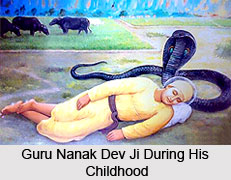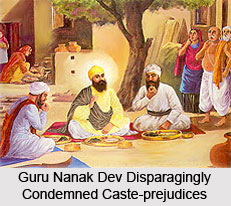 The founder of Sikhism, Guru Nanak was born in the year of 1469 in a village named Rai Bhoen di Talwandi, situated in Sheikhupura district of Pakistan, 65 km west of Lahore. According to some of the scholars, Guru Nanak was born in the middle of the month of Baishakh, Indian calendar on 15th April, 1469. However, his disciples traditionally celebrate his birthday on the full-moon night of the Indian month of Kartik, which falls in the months of October/November. His father`s name is Kalu Bedi and mother`s name is Tripta. His father was a revenue official in the village and a well-known person in the society.
The founder of Sikhism, Guru Nanak was born in the year of 1469 in a village named Rai Bhoen di Talwandi, situated in Sheikhupura district of Pakistan, 65 km west of Lahore. According to some of the scholars, Guru Nanak was born in the middle of the month of Baishakh, Indian calendar on 15th April, 1469. However, his disciples traditionally celebrate his birthday on the full-moon night of the Indian month of Kartik, which falls in the months of October/November. His father`s name is Kalu Bedi and mother`s name is Tripta. His father was a revenue official in the village and a well-known person in the society.
Guru Nanak`s father, Kalu consulted with the village pandit, Hardyal on the horoscope of Guru Nanak, soon after he was born and the pandit was overwhelmed with joy after finding what was there in Nanak`s future. Hardyal told Kalu that Nanak will be revered by both the Hindus and Turks and he will worship and acknowledge none but One Formless Lord. Hardyal added that Nanak will also teach others to do so and consider every creature as God`s creation. Hardyal then named the new born as `Nanak`, which was a much common name of both the Hindu and Muslims.
Guru Nanak led a life much like that of other children of his age, as a child he used to play with children of his age and frolicked around. However, he was not used to share all that he had, like goodies to eat, with his sister and friends, unlike many children. He loved to meet various holy men, like the fakirs, yogis and monks, who passed through Talwandi, during his childhood. At the age of five, Nanak`s father sent him to Pandha Gopal for study. Nanak received elementary education with an emphasis on language and arithmetic from Pandha Gopal and he also impressed Pandha Gopal with his poetic expression of lofty thoughts. A huge change took place in Nanak`s nature after the marriage of his elder sister, Nanaki, and he became sad and withdrawn. The reason was that Nanaki was a confidante of Nanak and she was such a person who provided Nanak the greatest understanding and affection.
After the marriage of his elder sister, Nanak was sent to Pandit Brijlal, known to be a brilliant teacher as well as spiritually blessed, to study for two years. The young Nanak was exposed to the traditional learning contained in Sanskrit classics by this. However, Brijlal did not continues teaching Nanak for long saying that Nanak had learned everything from him and also mentioned Nanak as an embodiment of spiritual wisdom. Then, Nanak went to a local maulvi named Qutab-ud-Din, to learn Persian and Arabic. Guru Nanak has done wonder here also and became proficient enough in the two languages to study their literature, within just two years.
Guru Nanak`s father made elaborate arrangements for giving Nanak janeu, at the age of thirteen. Janeu is the sacred thread, woven of seven cotton strings and it is mainly worn by upper-caste Hindus as a mark of their being `twice-born`. However, Nanak strongly refused to wear the Janeu, when Pandit Hardyal tried to place the thread across his shoulders. Nanak told that he does not believe in differentiating men by such badges (of the `twice-born`). Nanak continued to meet with the fakirs and yogis and also stood against some of the social customs of that period. He left his ancestral village at his teenage and went to live with his elder sister Nanaki and her husband, Jairam in Sultanpur. Guru Nanak never returned to Talwandi permanently, except from some occasional visits.









